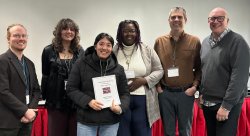Anthropology Students Present Original Research at NJ Archaeology Conference
Posted in: Anthropology, Archeology, Awards & Scholarships

Khara Brown (junior, anthropology major) and Emily Papagianis (junior anthropology major) each presented papers the annual conference of the Archaeological Society on New Jersey (ASNJ). The conference was held in Princeton, NJ on February 17, 2024. The ASNJ is the leading professional archaeological organization in New Jersey.
Khara Brown’s paper is a comparison between three free African American settlements founded in the 1800s. Seneca Village was a black community established in Manhattan in the 1820s and then razed in 1857 due the construction of Central Park. The Closter Mountain Community (aka Skunk Hollow) was established in 1806 by formerly enslaved man named Jack Earnest. The community was located in what is now Palisades Park near the NY-NJ border. Finally, Dunkerhook, was a community founded by formerly enslaved men and woman in the 1830s in Paramus, NJ. Each site has been excavated and studied by archaeologists but a comparison of the findings have never been done before.
Emily Papagiannis’ paper was an analysis of data from the census and cemetery records for the Dunkerhook community. The purpose of her study was to determine if the burial sites of all of the Dunkerhook residents documented by the census were known and where they are located. This accounting will help to understand the community networks Dunkerook people would have developed but also to know the likelihood that any burials still remain in the community, perhaps associated with the site of the AME Zion church that once stood on Dunkerhook Road.
Both papers were very well-received and the students handled the Q&A like pros!
